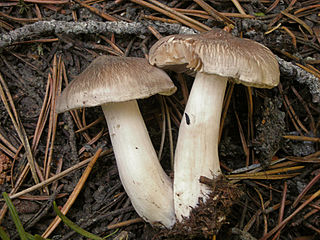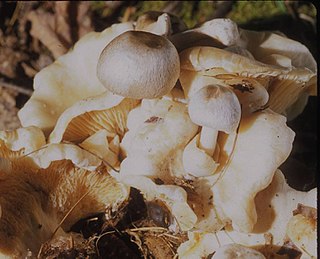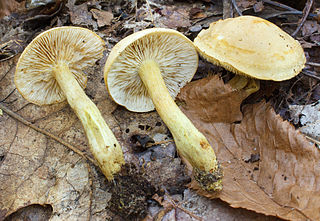
Tricholoma is a genus of fungus that contains many fairly fleshy white-spored gilled mushrooms which are found worldwide generally growing in woodlands. These are ectomycorrhizal fungi, existing in a symbiotic relationship with various species of coniferous or broad-leaved trees. The generic name derives from Ancient Greek: τριχο-, romanized: tricho-, lit. 'hair' and Ancient Greek: λῶμα, romanized: loma, lit. 'fringe, border' although only a few species have shaggy caps which fit this description.

Tricholoma pardinum, commonly known as spotted tricholoma, tiger tricholoma, tigertop, leopard knight, or dirty trich, is a gilled mushroom widely distributed across North America, Europe, and parts of Asia. It is generally found in beech woodland in summer and autumn. Two subspecies have been described from southern Europe. First officially described by Christiaan Hendrik Persoon in 1801, T. pardinum has had a confusing taxonomic history that extends over two centuries. In 1762, German naturalist Jacob Christian Schäffer described the species Agaricus tigrinus with an illustration corresponding to what is thought to be T. pardinum, and consequently, the name Tricholoma tigrinum has been used erroneously in some European field guides.
Tricholoma huronense is a mushroom of the agaric genus Tricholoma. It was first described in 1942 by American mycologist Alexander H. Smith based on collections made in Michigan.
Tricholoma venenatum is a mushroom of the agaric genus Tricholoma. It was first described scientifically by American mycologist George F. Atkinson in 1908.

Tricholoma myomyces is a mushroom of the agaric genus Tricholoma, usually considered to be a synonym of Tricholoma terreum. The species was first described scientifically by Christian Hendrik Persoon in 1794 as Agaricus myomyces, and later transferred to the genus Tricholoma by Danish mycologist Jakob Emanuel Lange in 1933. It is found in Europe and northern North America.

Tricholoma nigrum is a mushroom of the agaric genus Tricholoma. It was described as new to science in 1996 from a collection made on the Oregon Coast where it occurred with Pinus contorta. It has also been found in an old-growth conifer forest.

Tricholoma virgatum, commonly known as the ashen knight, is a mushroom of the agaric genus Tricholoma. It was first described scientifically as Agaricus virgatus by Elias Fries in 1818, and later transferred to the genus Tricholoma by Paul Kummer in 1871. It is found in the deciduous and coniferous forests of Europe, North America, and China. The mushroom is inedible, speculated to be poisonous, and has a bitter and peppery taste and musty odor.

Volvariella surrecta, commonly known as the piggyback rosegill, is an agaric fungus in the family Pluteaceae. Although rare, the species is widely distributed, having been reported from Asia, North America, Northern Africa, Europe, and New Zealand. The fungus grows as a parasite on the fruit bodies of other gilled mushrooms, usually Clitocybe nebularis. V. surrecta mushrooms have white or greyish silky-hairy caps up to 8 cm (3.1 in) in diameter, and white gills that turns pink in maturity. The stipe, also white, is up to 9 cm (3.5 in) long, and has a sack-like volva at its base.

Tricholoma aurantio-olivaceum is a mushroom of the agaric genus Tricholoma. It was first formally described by American mycologist Alexander H. Smith in 1944.
Tricholoma atroviolaceum is a mushroom of the agaric genus Tricholoma. It is from the fungi kingdom. It was described as new to science by American mycologist Alexander H. Smith in 1944. The mushroom seems to be exclusive to the Pacific coast of North America; it can be found in the Pacific Northwest under conifers, usually in sparse quantities.

Tricholoma apium is a mushroom of the agaric genus Tricholoma that is found in Europe. It is classified as vulnerable in the IUCN Red List of Threatened Species.
Tricholoma atrodiscum is a mushroom of the agaric genus Tricholoma. It was described as new to science in 1989.

Tricholoma cingulatum is a mushroom of the agaric genus Tricholoma. First described in 1830 as Agaricus cingulatus by Elias Magnus Fries, it was transferred to the genus Tricholoma by Almfelt in 1830.

Tricholoma luteomaculosum is a mushroom of the agaric genus Tricholoma. It was first formally described by American mycologist Alexander H. Smith in 1942.

Tricholoma manzanitae is a mushroom of the agaric genus Tricholoma. It was formally described in 1983.

Tricholoma odorum is a mushroom of the agaric genus Tricholoma. It was formally described in 1898 by American mycologist Charles Horton Peck. It is considered inedible.
Tricholomaolivaceobrunneum is a mushroom of the agaric genus Tricholoma. It was formally described in 1986.

Tricholoma populinum, commonly known as the poplar tricholoma, sandy, or cottonwood mushroom, is a mushroom of the agaric genus Tricholoma. It was formally described by Danish mycologist Jakob Emanuel Lange in 1933. It is traditionally eaten by the Salish Native Americans in British Columbia.












